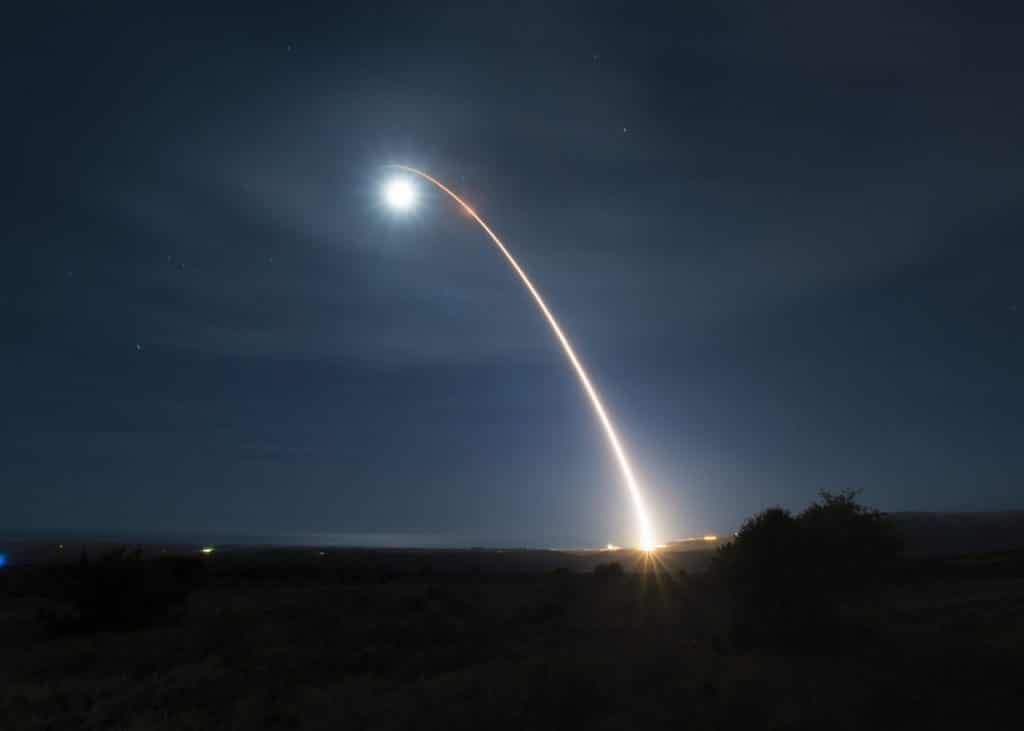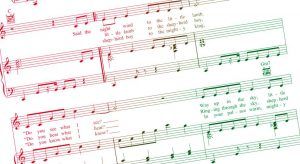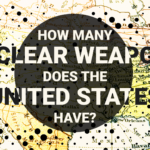The Christmas carol and the Cuban Missile Crisis
By Reba A. Wissner | December 19, 2022
 "A star dancing in the night, with a tail as big as a kite" — An unarmed Minuteman III intercontinental ballistic missile launched during a test at Vandenberg Air Force Base in California on February 5, 2020. US Air Force photo by Senior Airman Clayton Wear
"A star dancing in the night, with a tail as big as a kite" — An unarmed Minuteman III intercontinental ballistic missile launched during a test at Vandenberg Air Force Base in California on February 5, 2020. US Air Force photo by Senior Airman Clayton Wear
We often take Christmas carols at face value. But at least one holiday favorite, “Do You Hear What I Hear,” contains more than what first meets the ear.
Written during the height of the Cuban Missile Crisis, the song contains references to the fear of a nuclear attack. Many of the phrases it contains, such as “a star, dancing in the night, with a tail as big as a kite” can be interpreted in two ways: as the bright star of Bethlehem that leads the Magi to the baby Jesus—or as the sight of a nuclear missile in flight. “The star was meant to be a bomb,” the composers’ daughter, Gabrielle Regney, explained to GBH News, the magazine of the Boston public radio station, in 2019.
October 16 to November 20, 1962 was a tense month. Americans had discovered a store of Soviet missiles housed in Cuba, leading to the nuclear standoff known as the Cuban Missile Crisis. The world was on edge, unsure if the Soviet Union would attack the United States. On October 22, 1962, President John F. Kennedy addressed the nation, apprising them of the situation and letting them know how much danger they would be in should the missiles, with their advanced capabilities, be launched. Many people frequently listened to their radios to hear whether or not an attack had begun.

One of those people was Noël Regney and Gloria Shayne’s record producer, who had asked that the songwriting pair compose a Christmas carol as the B-side to a single they had coming out, according to an interview Regney later gave to the Connecticut newspaper The Ridgefield Press.
Such a request was tempered by the current political climate. Regney, a composer, had fought in his native France during World War II and seen the horrors of war firsthand. He braced himself for what could come next should the Soviet Union attack the United States and a third world war begin. On his way home from the record studio in New York City, Regney pondered the request, considering the pervasive threat of nuclear war and his disdain for the recent commercialization of Christmas. As Regney traveled, he passed women wheeling strollers on the street. He saw that the innocent children were looking at each other and smiling—which inspired the song’s first line: “Said the night wind to the little lamb,” reported The Atlantic in 2015.
But he also considered what would happen to those same children should the United States be attacked. By the time Regney arrived home, he had written the song in his head. But Regney was dissatisfied with the melody he had composed. (He usually did the melodies while his wife, lyricist Gloria Shayne, wrote the words.) As a result, they swapped their normal duties and Regney wrote the words while Shayne wrote the music, Regney explained in a 1985 interview with the New York Times.
In the way I read the song—I’m a musicologist at a university, with an emphasis on popular culture—almost everything in it has a double meaning or serves as an allegory for something else: the lamb a call for peace and the children Regney passed on the street, the child shivering in the cold referring to the children who would most certainly be killed in a nuclear attack, silver and gold as the cost of war. The song contains many of the same elements found in traditional Christmas songs—strophic form (every stanza of text is set to the same music), call and response elements, and shifts in volume and pitch in each stanza—making its hidden meaning all the more indistinguishable.

Each line begins with a question that is pitched low and the answer is found in the notes that are higher in the scale later in the stanza. Each stanza sees the story pass from person, thing, or animal to someone else: the night wind to the little lamb in stanza one, the little lamb to the shepherd boy in stanza two, the shepherd boy to the king in stanza three, and the king to the people—us—in stanza four. Important contextual and symbolic words—lamb, see, star, kite, boy, king, hear, know, song, child, sea, say, (every)where, light—fall on long sustained notes, a technique used as far back as medieval Catholic chants. The word “everywhere” is the only one that has its final syllable sustained and the rest of the word broken among three notes (a possible symbol for the Trinity) but also draws attention to the pair’s call for universal peace sung at its highest volume and called for by the king in the song.
Regney and Shayne penned the song as a call for peace during a time of uncertainty, said Regney’s 2002 obituary in the New York Times—would there even be a world after the Cuban Missile Crisis? The song’s message was so poignant that the pair had difficulty singing through it without crying. Regney and Shayne’s favorite version of the song, in fact, was performed by Robert Goulet because he nearly shouted the line “pray for peace,” which was the real message of the song, Regney told the Times.
The song’s first recording was by the Harry Simeone Chorale, the same group that popularized another Christmas favorite, “The Little Drummer Boy,” shortly before Thanksgiving 1962. “Do You Hear What I Hear” had an initial pressing of 250,000 copies that sold out within the first week of its release. Luckily, only a few days before the song was released, the Cuban Missile Crisis ended, though fear of nuclear war was still in the air.
Most people do not know how recent the song is or what its message really entails. In a 1985 interview, Regney made a remark that still holds true today: “I am amazed that people can think they know the song and not know it is a prayer for peace. But we are so bombarded by sound and our attention spans are so short that we now listen only to catchy beginnings.”
Since its 1962 release, there have been over 151 versions of the song released in multiple languages, the most recent performed by The Smashing Pumpkins’ Billy Corgan in a live coffee house show on December 19, 2021. However, probably the most famous version was recorded by Bing Crosby one year after its initial release; it remains a staple of the holiday season, selling over a million copies upon release. (And Regney became the first Noël to have a Christmas hit in the United States.)
The circumstances behind the song are still as relevant today as they were in 1962—only now, the Doomsday Clock sits at 100 seconds to midnight, the closest it has ever been to nuclear apocalypse. And that, certainly, is not a thought full of Christmas cheer.
Together, we make the world safer.
The Bulletin elevates expert voices above the noise. But as an independent nonprofit organization, our operations depend on the support of readers like you. Help us continue to deliver quality journalism that holds leaders accountable. Your support of our work at any level is important. In return, we promise our coverage will be understandable, influential, vigilant, solution-oriented, and fair-minded. Together we can make a difference.
Keywords: Cuban Missile Crisis, ICBM, Trinity, missile test, nuclear attack, popular culture
Topics: Nuclear Weapons, Opinion
















I was a sophomore in HS during the Cuban Missle Crisis and both my house and my school were about a mile from Griffiss AFB – one of the largest, if not the largest, SAC bases east of the Mississippi. It was an incredibly scary time.
I never realized this about the song – had to go back and listen to it.
Bitburg AB. A young 2Lt. More scared than any time in my life, including Vietnam. But for the grace of God!
And a century earlier the conflict of the times met the reflection of the poet in “I Heard the Bells on Christmas Day” by Henry Wadsworth Longfellow. Most of the poems’ verses aren’t sung anymore, but the full poem is still worth reflection. https://www.scottishpoetrylibrary.org.uk/poem/christmas-bells/ You can find more history and performance with a simple search. Worth it.
Citizens all over the US were terrified by the reckless brinkmanship practiced by both sides during the Cuban Missile Crisis. Imagine how Russia perceives the US as it encircles Russia with nuclear weapons right on its borders, extended NATO to the East, and flatly rejected Russian peace proposals at Helsinki?